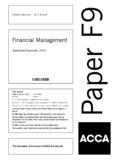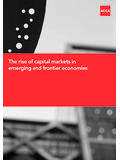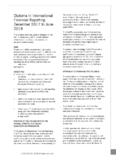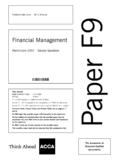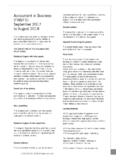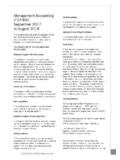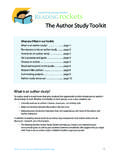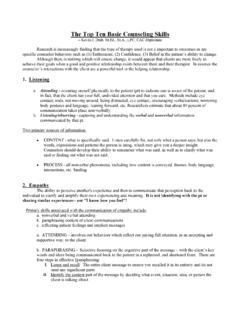Transcription of throughput accounting 2 - ACCA Global
1 RELEVANT TO ACCA QUALIFICATION PAPER F5 AND PERFORMANCE OBJECTIVES 12, 13 AND 14 2011 ACCA throughput accounting and the theory of constraints In the previous article, I told you all about The Goal, the book in which the theory of constraints and throughput accounting were introduced in the context of a novel. In this second article, I want to set out the five focusing steps of the theory of constraints, briefly explaining each one. Then, I will go through two examples showing you how these steps might be applied in practice or in exam questions. It s worth noting at this stage that, while the theory of constraints and throughput accounting were introduced in The Goal, they were further developed by Goldratt later. THE FIVE FOCUSING STEPS The theory of constraints is applied within an organisation by following what are called the five focusing steps.
2 These are a tool that Goldratt developed to help organisations deal with constraints, otherwise known as bottlenecks, within the system as a whole (rather than any discrete unit within the organisation.) The steps are as follows: Step 1: Identify the system s bottlenecks In my first article, I discussed how Alex Rogo and his team set out to identify the bottlenecks within the factory. They talked to factory workers and physically saw the machines in front of which were stacked up piles of inventory. Consequently, they were able to identify the bottlenecks, or constraints on production as being one of the new robotic machines (NCX 10) and the furnaces. Often, in exam questions, you will be told what the bottleneck resource is. If not, it is usually quite simple to work out. For example, let s say that an organisation has market demand of 50,000 units for a product that goes through three processes: cutting, heating and assembly.
3 The total time required in each process for each product and the total hours available are: Process Cutting Heating Assembly Hrs per unit 2 3 4 Total hours available 100,000 120,000 220,000 The total time required to make 50,000 units of the product can be calculated and compared to the time available in order to identify the bottleneck. Process Cutting Heating Assembly Hrs per unit 2 3 4 Total hrs required for 50,000 units 100,000 150,000 200,000 Total hours available 100,000 120,000 220,000 Shortfall in hours 0 30,000 0 2 throughput accounting AND THE THEORY OF CONSTRAINTS NOVEMBER 2011 2011 ACCA It is clear that the heating process is the bottleneck. The organisation will in fact only be able to produce 40,000 units (120,000/3) as things stand. Step 2: Decide how to exploit the system s bottlenecks This involves making sure that the bottleneck resource is actively being used as much as possible and is producing as many units as possible.
4 So, productivity and utilisation are the key words here. In The Goal , Alex noticed that the NCX 10 was sometimes dormant and immediately changed this by making sure that set ups took place before workers went on breaks, so that the machines were always left running. Similarly, the furnaces were sometimes left idle for extended periods before the completed parts were unloaded and new parts were put in. This was because workers were being called away to work on non-bottleneck machines, rather than being left standing idle while waiting for the furnaces to heat the parts. This was addressed by making sure that there were always workers at the furnaces, even if they had nothing to do for a while. Step 3: Subordinate everything else to the decisions made in Step 2 The main point here is that the production capacity of the bottleneck resource should determine the production schedule for the organisation as a whole.
5 Remember how, in the previous article, I talked about how new bottlenecks seemed to be appearing at the UniCo plant, because non-bottleneck machines were producing more parts than the bottleneck resources could absorb? Idle time is unavoidable and needs to be accepted if the theory of constraints is to be successfully applied. To push more work into the system than the constraint can deal with results in excess work-in-progress, extended lead times, and the appearance of what looks like new bottlenecks, as the whole system becomes clogged up. By definition, the system does not require the non-bottleneck resources to be used to their full capacity and therefore they must sit idle for some of the time. Step 4: Elevate the system s bottlenecks In The Goal, Alex was initially convinced that there was no way to elevate the capacities of the NCX 10 machine and the furnace without investing in new machinery, which was not an option.
6 Jonah made him and his team think about the fact that, while the NCX 10 alone performed the job of three of the old machines, and was very efficient at doing that job, the old machines had still been capable of producing parts. Admittedly, the old machines were slower but, if used alongside the NCX 10, they were still capable of elevating production levels. Thus, one of Alex s staff managed to source some of these old machines from one of UniCo s sister plants; they were sitting idle there, taking up factory space, so the manager was happy not to charge Alex s plant for the machines. In this way, one of the system s bottlenecks was elevated without requiring any capital investment. 3 throughput accounting AND THE THEORY OF CONSTRAINTS NOVEMBER 2011 2011 ACCA This example of elevating a bottleneck without cost is probably unusual.
7 Normally, elevation will require capital expenditure. However, it is important that an organisation does not ignore Step 2 and jumps straight to Step 4, and this is what often happens. There is often untapped production capacity that can be found if you look closely enough. Elevation should only be considered once exploitation has taken place. Step 5: If a new constraint is broken in Step 4, go back to Step 1, but do not let inertia become the system s new bottleneck When a bottleneck has been elevated, a new bottleneck will eventually appear. This could be in the form of another machine that can now process less units than the elevated bottleneck. Eventually, however, the ultimate constraint on the system is likely to be market demand. Whatever the new bottleneck is, the message of the theory of constraints is: never get complacent.
8 The system should be one of ongoing improvement because nothing ever stands still for long. I am now going to have a look at an example of how a business can go about exploiting the system s bottlenecks ie using them in a way so as to maximise throughput . In practice, there may be lots of options open to the organisation such as the ones outlined in The Goal. In the context of an exam question, however, you are more likely to be asked to show how a bottleneck can be exploited by maximising throughput via the production of an optimum production plan. This requires an application of the simple principles of key factor analysis, otherwise known as limiting factor analysis or principal budget factor. LIMITING FACTOR ANALYSIS AND throughput accounting Once an organisation has identified its bottleneck resource, as demonstrated in Step 1 above, it then has to decide how to get the most out of that resource.
9 Given that most businesses are producing more than one type of product (or supplying more than one type of service), this means that part of the exploitation step involves working out what the optimum production plan is, based on maximising throughput per unit of bottleneck resource. In key factor analysis, the contribution per unit is first calculated for each product, then a contribution per unit of scarce resource is calculated by working out how much of the scarce resource each unit requires in its production. In a throughput accounting context, a very similar calculation is performed, but this time it is not contribution per unit of scarce resource which is calculated, but throughput return per unit of bottleneck resource. throughput is calculated as selling price less direct material cost. This is different from the calculation of contribution , in which both labour costs and variable overheads are also deducted from selling price.
10 It is an important distinction because the fundamental belief in throughput accounting is that all 4 throughput accounting AND THE THEORY OF CONSTRAINTS NOVEMBER 2011 2011 ACCA costs except direct materials costs are largely fixed therefore, to work on the basis of maximising contribution is flawed because to do so is to take into account costs that cannot be controlled in the short term anyway. One cannot help but agree with this belief really since, in most businesses, it is simply not possible, for example, to hire workers on a daily basis and lay workers off if they are not busy. A workforce has to be employed within the business and available for work if there is work to do. You cannot refuse to pay a worker if he is forced to sit idle by a machine for a while. Example 1 Beta Co produces 3 products, E, F and G, details of which are shown below: E F G $ $ $ Selling price per unit 120 110 130 Direct material cost per unit 60 70 85 Maximum demand (units) 30,000 25,000 40,000 Time required on the bottleneck 5 4 3 resource (hours per unit) There are 320,000 bottleneck hours available each month.
